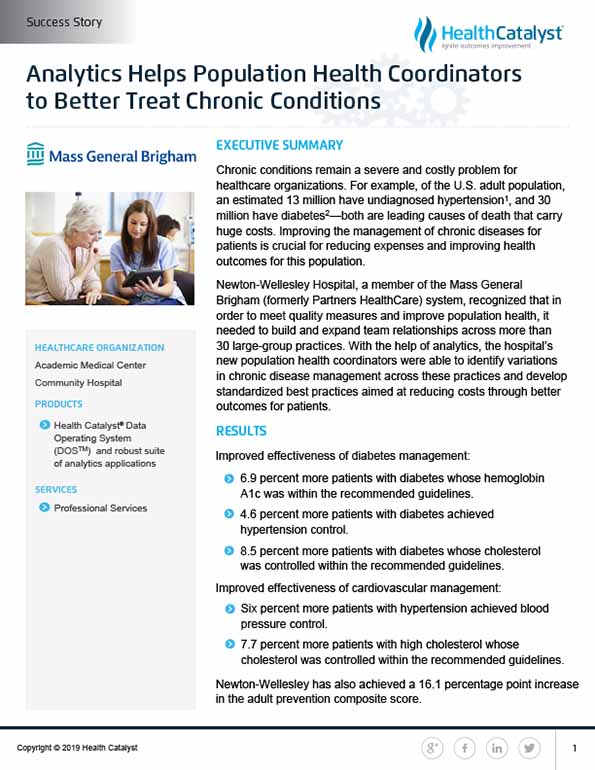Improving the management of chronic diseases for patients is crucial for reducing expenses and improving health outcomes. Newton-Wellesley Hospital, a member of the Mass General Brigham (formerly Partners HealthCare) system, adopted the population health coordinator role and utilized analytics to help identify variations in chronic disease management across practices and develop standardized best practices aimed at reducing costs through better outcomes for patients.
Chronic conditions remain a severe and costly problem for healthcare organizations. For example, of the U.S. adult population, an estimated 13 million have undiagnosed hypertension1, and 30 million have diabetes2—both are leading causes of death that carry huge costs. Improving the management of chronic diseases for patients is crucial for reducing expenses and improving health outcomes for this population.
Newton-Wellesley Hospital, a member of the Mass General Brigham system, recognized that in order to meet quality measures and improve population health, it needed to build and expand team relationships across more than 30 large-group practices. With the help of analytics, the hospital’s new population health coordinators were able to identify variations in chronic disease management across these practices and develop standardized best practices aimed at reducing costs through better outcomes for patients.
Chronic diseases carry a significant cost for healthcare organizations and patients. In the U.S., 12 percent of adults have five or more chronic conditions. However, this patient population accounts for a disproportionate 41 percent of the $3.3 trillion in healthcare expenditures annually.3,4 Each year, seven out of ten deaths among Americans are from chronic diseases.5
To reduce costs and improve outcomes, healthcare organizations must address the growing epidemic of chronic disease. Mass General Brigham is a large, non-profit integrated delivery network headquartered in Boston, Massachusetts. Through its system of 12 hospitals, 150 primary care practices, and physician network, it strives to meet population health needs, including improving outcomes and reducing costs associated with its patients with chronic illnesses. Newton-Wellesley Hospital, a member of Mass General Brigham, is committed to delivering high quality medical care to its primary care patients and upholds the Agency for Healthcare Research and Quality’s definition of quality: “Doing the right thing, at the right time, for the right person, and having the best possible result.” Because of the high risk of death associated with chronic illness, improving population health outcomes for this patient population is a top priority for Newton-Wellesley Hospital.
Newton-Wellesley Hospital determined that processes for managing chronic diseases such as hypertension, high cholesterol, and diabetes varied between practices. This variation made it challenging to demonstrate that the organization was meeting the expected population health quality measures. While care was documented in the EMR, it was difficult to use that information to evaluate performance over time due to the high level of practice variation.
As a result of unreliable data, providers had limited insight and knowledge about how the care they provided and documented affected patient outcomes and quality measures. The lack of visibility into performance made it challenging to determine where to focus improvement efforts. Providers were often unaware of which quality measures they had the opportunity to improve and how their performance compared to that of their peers.
Leadership at Newton-Wellesley Hospital recognized that to improve population health and reduce healthcare costs, it needed to build and expand team relationships across more than 30 large-group practices and expand access to meaningful performance data that could be used to drive improvements.
The ambulatory quality team at Mass General Brigham had implemented network-wide tools—including the population health coordinator (PHC) role, analytics platform and applications, and registries to improve outcomes. Newton-Wellesley Hospital utilized these tools to help drive improvement efforts and successful quality outcomes.
Newton-Wellesley Hospital adopted a PHC role to support frontline teams in improving the management of chronic health conditions. PHCs support providers and practices in quality performance improvement and facilitate quality, patient-centered care that improves timely access to, and provision of, preventative services, cancer screenings, and chronic disease treatment.
To aid in their work, PHCs leverage the Health Catalyst® Data Operating System (DOS™) and a robust set of analytics applications, including Mass General Brigham Quality Insights, in addition to data in the EMR. The data and analytics application are used to identify patients’ unmet needs, engage patients in their own care, gather summary information for treatment interventions, and enhance ongoing communication between patients and their care teams.
PHCs at Newton-Wellesley Hospital also utilize the Mass General Brigham Quality Insights analytics application and data from the EMR as a population health registry (see Figure 1). The analytics application allows the PHCs, and practices they support, to effectively monitor chronic and preventative disease quality measures. PHCs are able to capture and report timely, meaningful data related to chronic disease management and exception reporting for health maintenance.

Informed by data, the PHCs developed and implemented standard practices, in addition to implementing practice and provider specific strategies for improvement. PHCs are also responsible for coordinating patient outreach. When the data demonstrates a patient needs to receive specific preventative or primary care, the PHC contacts the patient and schedules them to be seen by a provider. PHCs also help to ensure patients are scheduled for follow-up appointments at the point of care.
When patients are being seen for a primary care visit, PHCs help ensure eligible patients are also scheduled for a mammogram on the same day, decreasing the number of trips the patient must make to the clinic.
Practices have implemented best practices for using data and inputting new information into the EMR. Additionally, the use of modifiers has been standardized. Practices have also made changes to maximize the medical assistant (MA) workflow, ensuring accurate data capture. To support this, documentation of quality measure exceptions has also been standardized to avoid variation.
Other practice-specific improvements that have been implemented include:
PHCs send data from the analytics application to the practices each week, identifying opportunities for improvement. Each quarter, the organization reviews un-blinded quality data, so that each provider can see their specific performance and how their performance compares to the practice of their peers. This ensures best practices are followed throughout the organization.
Using a data-driven approach and developing strategies to meet the needs of the various provider practices is yielding the desired results. In just one year, Newton-Wellesley Hospital has achieved the following results:
Improved effectiveness of diabetes management:
Improved effectiveness of cardiovascular management:
Additionally, Newton-Wellesley Hospital has also achieved a 16.1 percentage point increase in the adult prevention composite score.
“Using the analytics application, I was able to share physician-specific performance data with the lead medical assistant for a busy, eight physician practice. The medical assistant gained new insight and understanding about the quality measures and was able to better support the physician’s efforts in providing patients with the appropriate care, which improved quality scores.”
- Maria Hall, Senior Population Health Coordinator
Newton-Wellesley Hospital plans to continue its PHC program. Leadership also intends to use data to drive improvement in population health outcomes, better coordinating care for the management of other chronic diseases while further improving outcomes for its diabetic and hypertensive patient populations.


Improved effectiveness of diabetes management:
Improved effectiveness of cardiovascular management:
Newton-Wellesley has also achieved a 16.1 percentage point increase in the adult prevention composite score.


